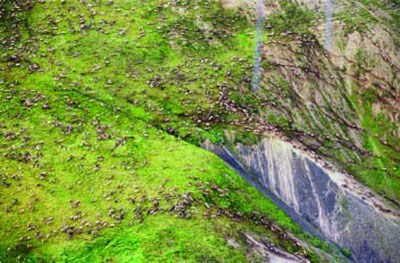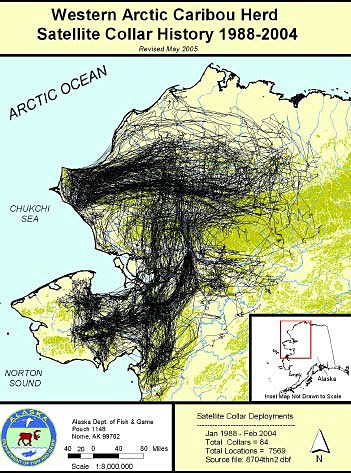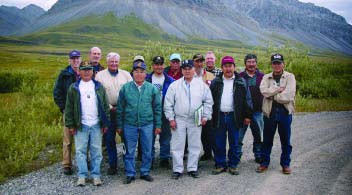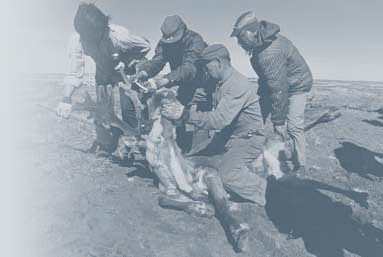Part of a series of articles titled The Legacy of ANILCA.
Article
ANILCA and the Western Arctic Caribou Herd Cooperative Management Plan
By Don Callaway

Photographs courtesy of John Trent, ADF&G
What is ANILCA?
The Alaska National Interest Lands Conservation Act (ANILCA) of 1980 was a negotiated Congressional compromise between Native, state, mining, sports, and environmental interest groups. Environmental groups saw a doubling of the National Park and Wildlife Refuge systems and a tripling of the National Wilderness Preservation system. Mining and oil interests saw the opening of Prudhoe Bay with concomitant huge profits. The state also benefited from development of oil, currently 85% of its revenues come from royalties and taxes on North Slope oil development. Rural communities, under Title VIII, were allowed to continue hunting and fishing for subsistence purposes in any area traditionally used in the past regardless of whether that area now exists as a “conservation system unit” (CSU)—e.g., National Parks or Wildlife Refuges.The framers of ANILCA seem prescient in their structuring of Title VIII, which reflects an awareness of the necessity to integrate local knowledge, values, and cooperation in the framing of a wildlife management regime. This awareness begins with Section 805, “Local and Regional Participation,” which establishes an upwelling of local information, opinion, and input into the regulatory process.
Section 812 of ANILCA, “Research,” directs the Secretary, acting through federal agencies such as the National Park Service, to undertake research on fish and wildlife and subsistence uses on the public lands; seek data from, consult with and make use of, the special knowledge of local residents engaged in subsistence uses…
Finally, Section 809, “Cooperative Agreements,” allows the Secretary of the Interior and his or her agents (e.g., the National Park Service) to share aspects of their authority with other concerned and involved agents.
Essentially these three sections of Title VIII form a vision of how the basic functions of wildlife management may be cooperatively enacted. This article describes how this basic framework was applied by John Trent and Dave Spirtes to overcome the very contentious issue of managing the Western Arctic Caribou Herd (WACH).

Figure courtesy of Peter Bente, ADF&G
The Western Arctic Caribou Herd
In March and April barren-ground caribou begin their great migration, small groups join together and long lines form as they move steadily north.The Western Arctic Caribou Herd ranges over a territory bounded by Prudhoe Bay on the north, south to the Yukon River and west to Unalakleet on the Seward Peninsula.During their migration, which might encompass several hundred miles over varying routes, the caribou may cross multiple boundaries and jurisdictions, including state, Native Corporation and various federal lands (all with differing management mandates).
The Western Arctic Caribou Herd at 450,000 animals is only one of about 32 herds in Alaska but is by far the largest, comprising about half of the caribou in the state (and about 10% of the world total of 5 million animals). Within the expanse of this great herd’s range are nestled about forty small communities that harvest caribou as part of a traditional subsistence lifestyle. In addition, the herd has a number of other human “constituencies,” including conservationists, sport hunters, hunting guides, and transporters.

Caribou and Indigenous Communities in Northwest Alaska
The size of human populations embedded in the herd’s territory vary; at one extreme is Kotzebue with slightly more than 3,000 people, 75% of which are Inupiat, and at the other extreme is Deering with about 140 people, more than 90% of which are Inupiat.While the typical U.S. per capita con-sumption of meat, fish and poultry is about 225 lbs., these two communities in northwest Alaska harvest more than twice that poundage of wildlife resources. While many northwest Alaska communities depend upon caribou for about a quarter of their subsistence harvest, some like Noatak, rely on caribou for nearly half of their subsistence needs (Table 1).
Rural northwest arctic communities are accessible only by air, and bulk items such as food and fuel oil are extremely expensive to transport. In 1990 while Anchorage food costs were about 25% greater than most cities in the Western U.S., the rural communities of northwest Alaska had food costs more than twice that of Anchorage. In 1990 the four communities enumerated in Table 1 had per capita incomes ranging from $5,000 to $14,000. If these communities were forced to replace wildlife harvests with store bought foods, the total replacement costs would range from 13% to 77% of the total per capita income for that community.
And while the nutrition and economic aspects of wildlife harvests seem the critical issue, in fact, it is the social relations in the harvest, processing, and sharing of these resources that are of paramount concern to the Alaska Natives of the region. Subsistence resources and the activities associated with their harvest provide more than food. Participation in family and community subsistence activities, whether it be clamming, processing fish at a fish camp or seal hunting with a father or brother provide the most basic memories and values in an individual’s life. These activities define and establish the sense of family and community. These activities also teach how a resource can be identified, methods of harvest, efficient and non-wasteful processing of the resource and preparation of the resource as a variety of food items.
The distribution of these resources establishes and promotes the most basic ethical values in Native and rural culture—generosity, respect for the knowledge and guidance of elders, self-esteem for the hunter engaged in the successful harvest of a resource, and public appreciation in the distribution of the harvest. No other set of activities provide a similar moral foundation.

Photograph courtesy of Peter Bente, ADF&G
Conflict: The Western Arctic Caribou Herd Crashes
Caribou lead a precarious existence. The population of large herds fluctuates through dramatic ups and downs, influenced by a complex number of factors. With herds the size of the WACH, the predominant factors seem to be related to climate.In the mid 1970s the Western Arctic Caribou Herd seemed to have experienced a severe crash. Based on aerial surveys, the herd size went from about 250,000 animals in 1970 to about 75,000 animals in 1976. During this period human harvest was estimated at 15,000-20,000 per year. The Alaska Department of Fish and Game (ADF&G) immediately imposed a harvest limit of 3,000 bull caribou. Unfortunately, the main herd was passing closer than usual to coastal and lower Kobuk River communities, so the villagers who depended on this resource did not believe the biologists’ assertion that caribou had sharply declined.
Lacking collared animals, the aerial surveys had probably missed a significant number of animals that had been seen by Native hunters. This conclusion is suported by the fact that two years later another survey counted over 106,000 animals, a 30% increase over the 1976 estimate. It is extremely unlikely that biological processes accounted for this increase in such a short time.
Despite the threat of arrest, the local harvest of caribou during this crisis period substantially exceeded the quota established by the Alaska Board of Game. In addition, the vast majority of harvesters evaded compliance with “compulsory” harvest reporting provisions. In 1977 ADF&G reported that for the entire range of the herd, only 19% of the hunters had returned permits as required by law (ADF&G 1977).
It was in this context of distrust and widespread non-compliance that a trio of individuals, John Trent and his supervisor John Cody of the ADF&G and Dave Spirtes of the National Park Service, utilized research conducted by the NPS and the provisions of ANILCA to initiate a new management plan.
The Cooperative Management Research Project
In 1995 the NPS completed a draft report entitled The Western Arctic Caribou Herd: Barriers and Bridges to Cooperative Management (Spaeder et al. 2003). This report investigated how a cooperative caribou harvest assessment program might contribute to greater trust among Native hunters and federal and state managers. The report detailed a number of case studies and also described and analyzed how cooperative management approaches might be devised to deal with the four general functions of wildlife resource management—research, allocation, regulation, and enforcement. Topically, the report included:1) A history of the response by subsistence communities to wildlife regulations;
2) A discussion of issues related to law enforcement versus self-regulation and local enforcement;
3) A detailed description of the deficiencies in existing harvest reporting programs and an explanation for lack of community compliance with harvest reporting requirements;
4) An extensive description of Traditional Ecological Knowledge (TEK) and the important role it plays in cooperative management regimes; and
5) A comparison of three case studies of harvest allocation methods from Alaska.

National Park Service photograph by Bob Belous, ARCC
The WACH Cooperative Management Plan
In the mid 1990s an initiative was spearheaded by John Trent of the ADF&G to create a cooperative management plan for the Western Arctic Caribou Herd, and shortly thereafter Dave Spirtes, NPS Super-intendent for northwest Alaska parks, partnered with Trent. Both agencies, along with the U.S. Fish and Wildlife Service and the Bureau of Land Management, supplied fiscal resources and administrative support to create the Western Arctic Caribou Herd Working Group in 1997. In addition to personnel from the federal agencies, the working group contained 20 voting chairs representing communities and user groups (including hunting guides and con-servation groups) dependent on the herd.Using the 1995 draft research report as a conceptual structure, the working group engaged in a number of meetings, including a key meeting in August of 2000 at Anaktuvuk Pass where Dave Spirtes presented a draft management plan. Wishing to avoid the breakdown in communication and conflicts surrounding the last crash of caribou in the 1970s, John Trent, Dave Spirtes, and the working group succeeded in drafting a plan, despite the absence of a pressing management crisis, making this plan all the more remarkable and perhaps unique in Alaska literature. After consider-able work and debate, The Western Arctic Caribou Herd Cooperative Management Plan was signed in March of 2003.
The purpose of the plan is to ensure the long-term conservation of the Western Arctic Caribou Herd and to maintain traditional and other uses of this important species. The plan itself, endorsed by twenty-four signatories, provides for joint management actions at three threshold points. At the lowest threshold point, when herd size is below 200,000 animals, a variety of recommendations kick into place, including a ban on the harvest of cows or calves, maintenance of a minimum bull:cow ratio, and the restriction of harvest to local residents only.
Several elements dealing with research, allocation, and regulation will be discussed in the sections below. The whole plan itself, including detailed maps, graphs and charts is available.
Research
As mentioned above, there had been very little agreement between land managers and local communities as to the actual size of the herd. To overcome the impasse, a number of cooperative research arrangements were put into place. Two efforts stand out. First, after hunters regularly complained that transects flown by observer planes often missed pockets of caribou, photographic surveys of caribou are now often carried out with hunters on board the planes. Both sides benefit from this process—the biologists attain more valid estimates of herd size and local hunters are more likely to accept these estimates since their input is now an integral part of the process.The second cooperative research arrangement involves collecting key information about the health of the herd. One way to achieve this is by having hunters collect measurements on the individual caribou they kill. These measurements and observations include proportion of body fat, condition of bone marrow, presence of parasites, gross body weight, and so forth.
Local hunters using aspects of traditional knowledge maintain a dialogue with the biologists (who input these measurements into a variety of models) as they jointly assess the health of the herd. Efforts such as these tend to lead to a convergence of estimates on both herd size and the health of the herd, although both parties may still disagree as to why and how these outcomes have occurred.
Allocation
Although the draft co-management plan has set threshold limits for reducing human harvests (see above), it has not established community allocation quotas. Since the numbers of caribou in the WACH are at historic highs, formula for community specific allocations have not yet been developed. When an eventual crash does occur, the process will probably unfold along lines similar to the Kilbuck Caribou Management Agreement, whereby com-munity harvest limits will be assigned by the Native representatives in the working group. Their decision, as Spaeder notes, can be seen as an expression of the indige-nous value of sharing. Respondents stated that they felt it was important to share things over which one cannot extend ownership, such as big game. No one “owns” the caribou, respondents asserted...(Spaeder 1995).
Regulation
In their negotiations and discussions leading to the enactment of ANILCA, the U.S. Congress determined that: the opportunity for rural residents of Alaska, with personal knowledge of local conditions and the requirements to participate effectively in the management and regulation of subsis-tence resources on the public is important in order to assure both the continued viability of fish and wildlife populations of national importance and the ability of rural people engaged in a subsistence lifestyle to continue to do so.Section 805 of ANILCA mandates the implementation of Regional Advisory Councils (RACs), which are composed of local subsistence hunters, who develop proposals that are forwarded to the Federal Subsistence Board. These proposals suggest who should be eligible to hunt, when the hunt should occur (seasons), and what is a reasonable amount to meet community and household needs (bag limits). Proposals from RACs carry considerable weight with the Federal Subsistence Board. In fact, the board is under substantial constraints if they choose to reject the proposals. Grounds for rejection revolve around proposals that might potentially harm the resource. Thus Section 805 provides for the incorporation of local experience and perspective of the landscape into western management practices. The WACH planning committee and working group intend to utilize the RAC process to submit proposals for reasonable and equitable seasons and bag limits to the Federal Subsistence Board.

Community Perspectives
“Without ANILCA it’s almost certain that Athabaskan cultural values would have gone extinct. Subsistence is the one common thread that ties all Athabaskan people together. Without federal intervention, the state’s political and legal processes wouldhave exhausted limited Native resources to keep up the subsistence battle. Even though ANILCA is full of statutory conflicts, and the federal system has its own oppressions, [Title VIII of] ANILCA offered a tool to unite all Indian groups to do battle with the state.”
- Wilson Justin, Vice President for the Mount Sanford Tribal Consortium, Chistochina and Twin Lakes
“There have been a lot of studies done and a lot of money spent on documenting subsistence resource use—harvests, how much we eat, how many people live in our homes, how much money we make, and so on—that’s really putting us under the microscope. Researchers get the data they need to satisfy their programs and discard the other concerns. For example, subsistence users are continually saying that sport hunting and fishing is affecting the subsistence resources—especially caribou and moose. The increasing numbers of motorized boats and planes are scaring the animals away. These observations continually gets documented, but with no action.”
- Karen E. Stickman, Project Coordinator, Native American Fish and Wildlife Society, Anchorage
References
Alaska Department of Fish and Game (ADF&G). 1977.
Results of the Fall 1977 Western Arctic Herd Permit Hunt.
Division of Wildlife Conservation, Alaska Department of Fish and Game.
Spaeder, J. 1995
The Qavilnguut (Kilbuck) Caribou Herd: An Alaskan Example of Cooperative Management. Report to the Eighteen Participating Yup’ik Villages, Alaska Department of Fish and Game,
and U.S. Fish and Wildlife Service.
Spaeder, J., D. Callaway and D. Johnson. 2003.
The Western Arctic Caribou Herd (WACH): Barriers and Bridges to Cooperative Management.
National Park Service
Western Arctic National Parklands, Kotzebue and the Cooperative Ecological Studies Unit, University of Washington, Seattle.
Alaska Department of Fish and Game (ADF&G). 1977.
Results of the Fall 1977 Western Arctic Herd Permit Hunt.
Division of Wildlife Conservation, Alaska Department of Fish and Game.
Spaeder, J. 1995
The Qavilnguut (Kilbuck) Caribou Herd: An Alaskan Example of Cooperative Management. Report to the Eighteen Participating Yup’ik Villages, Alaska Department of Fish and Game,
and U.S. Fish and Wildlife Service.
Spaeder, J., D. Callaway and D. Johnson. 2003.
The Western Arctic Caribou Herd (WACH): Barriers and Bridges to Cooperative Management.
National Park Service
Western Arctic National Parklands, Kotzebue and the Cooperative Ecological Studies Unit, University of Washington, Seattle.
Last updated: July 27, 2017
